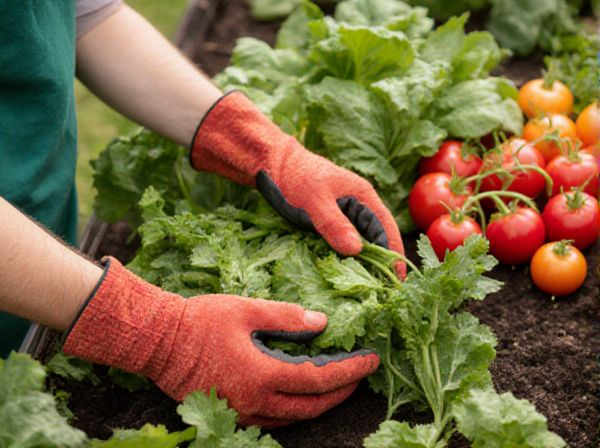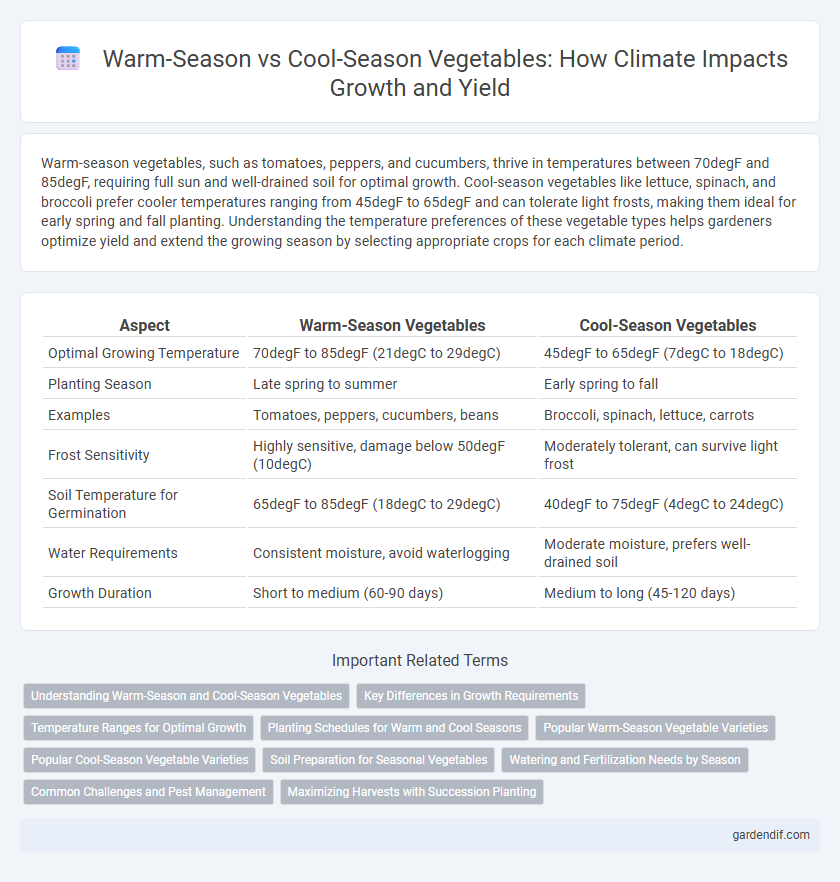
Warm-Season Vegetables vs Cool-Season Vegetables Illustration
Warm-season vegetables, such as tomatoes, peppers, and cucumbers, thrive in temperatures between 70degF and 85degF, requiring full sun and well-drained soil for optimal growth. Cool-season vegetables like lettuce, spinach, and broccoli prefer cooler temperatures ranging from 45degF to 65degF and can tolerate light frosts, making them ideal for early spring and fall planting. Understanding the temperature preferences of these vegetable types helps gardeners optimize yield and extend the growing season by selecting appropriate crops for each climate period.
Table of Comparison
| Aspect | Warm-Season Vegetables | Cool-Season Vegetables |
|---|---|---|
| Optimal Growing Temperature | 70degF to 85degF (21degC to 29degC) | 45degF to 65degF (7degC to 18degC) |
| Planting Season | Late spring to summer | Early spring to fall |
| Examples | Tomatoes, peppers, cucumbers, beans | Broccoli, spinach, lettuce, carrots |
| Frost Sensitivity | Highly sensitive, damage below 50degF (10degC) | Moderately tolerant, can survive light frost |
| Soil Temperature for Germination | 65degF to 85degF (18degC to 29degC) | 40degF to 75degF (4degC to 24degC) |
| Water Requirements | Consistent moisture, avoid waterlogging | Moderate moisture, prefers well-drained soil |
| Growth Duration | Short to medium (60-90 days) | Medium to long (45-120 days) |
Understanding Warm-Season and Cool-Season Vegetables
Warm-season vegetables, such as tomatoes, peppers, and cucumbers, thrive in temperatures between 70degF and 85degF and require full sun exposure for optimal growth. Cool-season vegetables like spinach, broccoli, and carrots perform best in cooler temperatures ranging from 45degF to 65degF, tolerating light frost and partial shade. Understanding these temperature preferences helps gardeners optimize planting schedules and maximize vegetable yield in various climate zones.
Key Differences in Growth Requirements
Warm-season vegetables such as tomatoes, peppers, and cucumbers thrive in temperatures between 70degF and 85degF, requiring full sun and well-drained soil for optimal growth. Cool-season vegetables like lettuce, spinach, and broccoli prefer cooler temperatures ranging from 45degF to 70degF and can tolerate partial shade and moist, fertile soil. The key difference lies in their temperature tolerance and sunlight needs, which dictate planting schedules and cultivation practices.
Temperature Ranges for Optimal Growth
Warm-season vegetables such as tomatoes, peppers, and cucumbers thrive at temperatures between 70degF and 85degF, requiring consistently warm soil and air to maximize growth and fruit production. Cool-season vegetables like lettuce, spinach, and broccoli grow best in temperatures ranging from 45degF to 70degF, favoring cooler conditions that prevent bolting and promote leafy development. Maintaining optimal temperature ranges reduces stress, maximizes photosynthesis, and ensures higher yield and quality for each vegetable type.
Planting Schedules for Warm and Cool Seasons
Warm-season vegetables such as tomatoes, peppers, and cucumbers thrive when planted after the last frost date, typically in late spring to early summer, as they require soil temperatures above 60degF (16degC) for optimal germination. Cool-season vegetables including lettuce, spinach, and broccoli are best planted in early spring or late summer, tolerating cooler soil temperatures around 40degF to 75degF (4degC to 24degC) and often maturing before the onset of high summer heat. Proper alignment with these planting schedules maximizes growth, yield, and nutrient content by leveraging temperature-specific climate conditions.
Popular Warm-Season Vegetable Varieties
Tomatoes, peppers, and cucumbers rank among the most popular warm-season vegetable varieties, thriving in temperatures between 70degF and 85degF. These vegetables require full sun and well-drained soil to maximize yield during the growing season. Selecting heat-tolerant cultivars like cherry tomatoes, jalapenos, and slicing cucumbers boosts productivity in warm climates.
Popular Cool-Season Vegetable Varieties
Popular cool-season vegetable varieties include kale, spinach, broccoli, cauliflower, and carrots, all of which thrive in temperatures between 45degF and 75degF. These crops prefer early spring or fall planting to avoid heat stress and ensure optimal growth. Their ability to withstand light frosts makes them ideal for regions with fluctuating temperatures during transitional seasons.
Soil Preparation for Seasonal Vegetables
Warm-season vegetables such as tomatoes, peppers, and cucumbers thrive in well-drained, nutrient-rich soil with a pH between 6.0 and 6.8, requiring thorough soil warming before planting to promote root development. Cool-season vegetables like lettuce, spinach, and broccoli prefer looser soil with higher organic matter and a slightly acidic to neutral pH (6.0 to 7.0), benefiting from thorough soil loosening and compost incorporation to retain moisture during cooler temperatures. Effective soil preparation involves adjusting soil temperature and fertility through organic amendments and proper tilling techniques tailored to each vegetable type to optimize growth and yield in their respective seasons.
Watering and Fertilization Needs by Season
Warm-season vegetables such as tomatoes and peppers require consistent watering and higher nitrogen fertilization during hot months to support rapid growth and fruit development. Cool-season vegetables like lettuce and broccoli prefer moderate watering schedules and balanced fertilization rich in phosphorus and potassium to withstand cooler temperatures and promote root health. Adjusting watering frequency and nutrient application according to the specific season enhances vegetable yield and maintains soil fertility effectively.
Common Challenges and Pest Management
Warm-season vegetables such as tomatoes and peppers face challenges like heat stress and increased pest activity from aphids and whiteflies during hot months, requiring vigilant pest management and mulching to retain soil moisture. Cool-season vegetables like lettuce and broccoli encounter issues with fungal diseases and root maggots in cooler, moist conditions, necessitating crop rotation and organic fungicides for effective control. Both types demand integrated pest management strategies, including monitoring and natural predators, to minimize chemical usage and promote sustainable growth in varying climate conditions.
Maximizing Harvests with Succession Planting
Succession planting of warm-season vegetables such as tomatoes, peppers, and cucumbers maximizes harvests by staggering planting times to extend the growing season and increase yield. Cool-season vegetables like spinach, lettuce, and broccoli thrive with early spring and fall succession planting, allowing continuous production during cooler months. Implementing tailored succession schedules based on temperature tolerance and maturation rates ensures a consistent supply of fresh produce throughout varying climate conditions.
Warm-Season Vegetables vs Cool-Season Vegetables Infographic

 gardendif.com
gardendif.com